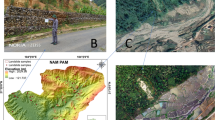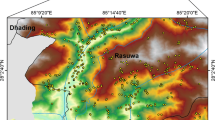Abstract
Cluster analysis and maximum likelihood classification (MLC) are exploited to map the post-earthquake landslide susceptibility in Beichuan County that was affected by the Ms 8.0 Wenchuan earthquake. The methodology is applicable even if there is short of training data. Six effective factors are chosen for mapping the susceptibility, including land use, seismic intensity, average annual rainfall, relative relief, slop gradient and lithology. Four clusters are grouped from sampling grid cells by k-means clustering approach. MLC classifies all the cells in the study area into the four clusters according to their statistical characteristics. Four susceptibility classes (extreme low, low, moderate and high) are assigned to these clusters applying expert experience and hazard density. The final map gives a reasonable assessment of post-earthquake landslide susceptibility in Beichuan County. Comparing with the pre-earthquake susceptibility map made in Beichuan County geological disaster survey project, the result t using cluster and MLC classification has a better agreement with the dot density value of post-earthquake landslides in Beichuan County. The susceptibility map can be used to identify safety spots within the high danger area, which are suitable for habitations and facilities. It is also found that more landslides are densely concentrated at the boundary between high and moderate regions, and between high and extreme low regions.








Similar content being viewed by others
References
Carrara A, Crosta G, Frattini P (2008) Comparing models of debris-flow susceptibility in the alpine environment. Geomorphology 94:353–378
Cui P, Chen XQ, Zhu YY et al (2011) The Wenchuan earthquake (May 12, 2008) Sichuan Province, China, and resulting geohazards. Nat Hazards 56:19–36
Dai FC, Lee CF (2002) Landslide characteristics and, slope instability modeling using GIS, Lantau Island, Hong Kong. Geomorphology 42:213–228
Ercanoglu M (2005) Landslide susceptibility assessment of SE Bartin (West Black Sea region, Turkey) by artificial neural networks. Nat Hazard Earth Syst 5:979–992
Garcia-Rodriguez MJ, Malpica JA, Benito B, Diaz M (2008) Susceptibility assessment of earthquake-triggered landslides in El Salvador using logistic regression. Geomorphology 95:172–191
He YP, Beighley RE (2008) GIS-based regional landslide susceptibility mapping: a case study in southern California. Earth Surf Proc Land 33:380–393
Huang R, Li W (2008) Research on development and distribution rules of geohazards induced by Wenchuan earthquake on 12th may 2008. Chin J Rock Mech Eng 27(12):2585–2592 (in Chinese)
Kamp U, Growley BJ, Khattak GA, Owen LA (2008) GIS-based landslide susceptibility mapping for the 2005 Kashmir earthquake region. Geomorphology 101:631–642
Lan HX, Zhou CH, Wang LJ, Zhang HY, Li RH (2004) Landslide hazard spatial analysis and prediction using GIS in the Xiaojiang watershed, Yunnan, China. Eng Geol 76:109–128
Lee S, Ryu JH, Min KD, Won JS (2003) Landslide susceptibility analysis using GIS and artificial neural network. Earth Surf Proc Land 28:1361–1376
Lin ML, Tung CC (2004) A GIS-based potential analysis of the landslides induced by the Chi–Chi earthquake. Eng Geol 71:63–77
Santacana N, Baeza B, Corominas J, De Paz A, Mar-turiá J (2003) A GIS-based multivariate statistical analysis for shallow landslide susceptibility mapping in La Pobla de Lillet area (Eastern Pyrenees, Spain). Nat Hazards 30:281–295
Suzen ML, Doyuran V (2004) Data driven bivariate landslide susceptibility assessment using geographical information systems: a method and application to Asarsuyu catchment, Turkey. Eng Geol 71:303–321
Tang C, Liang J (2008) Characteristics of debris flows in Beichuan epicenter of the Wenchuan earthquake triggered by rainstorm on September 24, 2008 [J]. J Eng Geol 16(6):751–758 (in Chinese)
Van Westen CJ, Rengers N, Soeters R (2003) Use of geomorphological information in indirect landslide susceptibility assessment. Nat Hazards 30:399–419
Xie X, Wei F, Lan D (2011) Sensitivity of landslide to land use in Xiaojiang River Basin [J]. J Nat Disasters 20(1):115–123 (in Chinese)
Acknowledgments
This work has been funded by the National Natural Science Foundation of China (Grant No. 41101164 and 41371185), the Project Group of Knowledge Innovation Program of Chinese Academy Sciences (KZCX2-YW-Q03-5) and the National Basic Research Program of China (973 Program) (Grant No. 2011CB409902).
Author information
Authors and Affiliations
Corresponding author
Rights and permissions
About this article
Cite this article
Ding, M., Hu, K. Susceptibility mapping of landslides in Beichuan County using cluster and MLC methods. Nat Hazards 70, 755–766 (2014). https://doi.org/10.1007/s11069-013-0854-0
Received:
Accepted:
Published:
Issue Date:
DOI: https://doi.org/10.1007/s11069-013-0854-0




